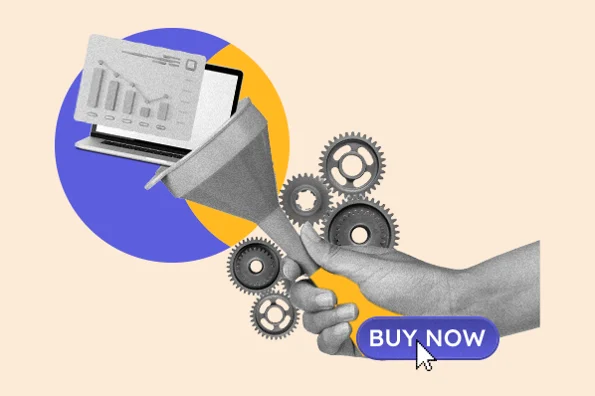Though every business is different, their sales processes all seem to gravitate to one specific progression. I think of it as a continuum that starts with a sales development process and ends with revenue generation. And it’s true for new business acquisition as well as expansion of existing business. The typical sales process in the simplest terms goes something like this:
.jpg?width=595&height=400&name=Sales%20Process%20Steps%202%20%281%29.jpg)
- Do target audience research.
- Create awareness and generate leads.
- Make contact, arrange a meeting, and/or conduct a presentation.
- Submit a proposal and win the business.
- Repeat.
But in most cases, that's not enough. There should be more to a sales process. Most successful ones are carried out with two underlying goals in mind — establishing credibility and building trust.
Once those two bases are covered, revenue gets generated. And while those objectives provide the backbone for an effective sales process, there are some other interrelated and supporting components that need to work to see solid results. Here they are.
Sales Process Stages
- Qualification
- Preparation
- Approach
- Presentation
- Realization
- Perform-ication
- Communication
- Continuation
For the sake of example, we're going to follow the sales process of a rep from an educational curriculum and scheduling software company.
1. Qualification
This is the stage where qualitative, quantitative, demographic, and psychographic research are analyzed to gain insight into prospect behavior and buying patterns.
It’s where prospect identification, confirmation, and lead generation come in. Inbound marketing, social media, and content marketing efforts — in addition to other available resources like email scheduling tools — help generate qualified leads, greatly reduce cold calling, and shorten the sales cycle considerably.
Let's say our educational curriculum and scheduling software company operates a popular blog. It publishes an article about the merits of using cloud storage for student information. The article features a call to action that links to a content offer — a webinar on how colleges can use technology to adapt to disruptions to conventional school years.
A high-level administrator from a community college in Northern California reads the article, clicks on the call to action, and provides their contact information in exchange for access to the webinar.
Our rep takes that information and sets up a discovery call with this administrator. On the call, the rep asks relevant, thoughtful questions to get valuable insight into whether this prospect is a good fit in terms of the school's size, problems, budget, and other key traits.
Let's say our salesperson asks all the right questions and gets the answers they need. Now, the prospect is a qualified lead, and they can move on through the sales process.
2. Preparation
This sales process stage encompasses a variety of diverse sales skills, such as meeting preparation, creating interest, anticipating and overcoming objections, presenting, consulting, audience engagement techniques, closing gestures, follow-up, and more — a lot more.
And preparation isn't just a one-time thing — it’s ongoing. Some of the other preparation components encompass understanding the competitive landscape and challenges faced by your prospects, confirming that your products and services will address those challenges and do it in a cost-effective, needs-based manner, and establishing quantifiable value.
If you can't do all of these things, you're not truly prepared.
In our example, our salesperson would take the time to understand the challenges a school of that size faces, the budget it might have allocated for scheduling software, how it compares to other community colleges in Northern California in terms of enrollment and endowment, and several other factors that would provide context for the school's unique challenges.
That way, our salesperson can best establish how their product can fit its needs and help them overcome the overarching issues and concerns it faces.
3. Approach
During the approach stage, you apply the knowledge you've gathered during the previous steps to start framing more substantial interactions. It's where you make your first contact after the lead is qualified. That could happen over the phone, through a face-to-face meeting, via video chat, or through some other particularly immediate medium.
In this stage, you leverage your company-specific insight and general sales acumen to intrigue your prospect — you create enough actionable curiosity to warrant a more thorough presentation. There are multiple methods you can use in this stage. Three of the most prominent are the premium approach, the question approach, and the product approach.
Premium Approach
With the premium approach, you offer a prospect some sort of promotional item or gift. That could be anything from a gift card to something specific to your company or industry. In our educational curriculum and software example, our rep might offer the prospect a year's subscription to a prestigious, expensive academic journal.
Question Approach
The question approach involves less schmoozing and more critical thinking. It's where you ask a question — or series of questions — that gets your prospect to critically evaluate their current pain points.
In our example, our rep might try to ask questions about specific professors' experiences with or complaints about the college's current scheduling process, hoping that the prospect will see cracks in its current situation from a perspective they hadn't considered.
Product Approach
Finally, the product approach involves offering a prospect a sample or free trial of your product or service to give them a picture of what the product looks like. Considering the scale and nature of the product in our example, our rep might not be able to pull this one off. Instead, they would give the prospect that kind of preview in the next stage — presentation.
4. Presentation
Assuming you’ve done all your homework in the first two stages of the process, you may be fortunate enough to book a meeting. The stage following the meeting and/or presentation will be determined by how well you have nailed down the prior two steps and how well you perform your demo — and yes, it is a performance.
So you better know what you’re talking about and rehearse it to the point that you could do it in your sleep while still seeming "spontaneous." It’s an art form. It’s also an important part of building credibility and establishing trust.
In our example, the rep had better know the ins and outs of the college's student body, the total number of faculty, the specific courses it's known for, the size of the campus itself, the number of classrooms, and any other information or factors that could possibly be affected or improved by leveraging the rep's software.
5. Realization
Once you’ve made it past the first three stages successfully, you might have earned the opportunity to present a proposal. This is where your agreed-upon client needs-based analysis and quantified value benefits need to be clearly laid out and justified. If they aren't, don’t even bother submitting a proposal.
Our rep would need to take all of the information from the presentation stage and be able to apply it. They would have to definitively demonstrate what the software would do for the college — supported by legitimate figures.
If the software's ability to streamline scheduling would make the college more efficient, they would have to show exactly what that means in quantifiable terms.
6. Perform-ication
Okay, so I made that one up to keep with the "-ation" motif. Really, this sales process stage is about obligation. If you’re fortunate enough to be awarded the business — which can often come down to timing and luck — it becomes your obligation to make certain you’ll deliver on what you proposed and what the client agreed to.
Here, the onus of excellent service and performance shifts partially from the rep to the product itself. In our example, the school better see the results it was promised. The scheduling process has to get considerably easier as a result of using the software. Otherwise, the rep's entire effort would just be some digital snake oil pitch.
7. Communication
An integral part of the process is keeping both internal and external contacts involved and in the loop. Use your CRM system — that’s what it’s for. But above all, make sure you keep the client updated and do it regularly. If you did well, tell them. If you encountered an issue, tell them about it and explain how it was corrected. They’ll respect you in both instances.
8. Continuation
This is an often-overlooked and underutilized stage of the process — despite containing hidden revenue-generating opportunities. How do I know? Because I’ve seen it happen ... and not happen. By neglecting to reinforce value, organizations miss opportunities to justify the client's decision, often making them lose out on referrals and upsell business.
Now, there's no guarantee your sales process will be totally in keeping with the steps listed above. Yours could differ based on factors like sales style, training, and experience. Still, the sequence detailed in this article can serve as an effective reference point for virtually any company looking to put an effective sales process together.
Editor's note: This post was originally published in May 2015 and has been updated for comprehensiveness.







.jpg)


